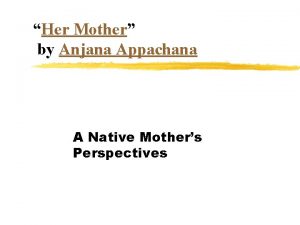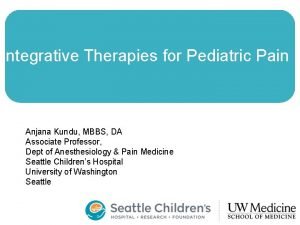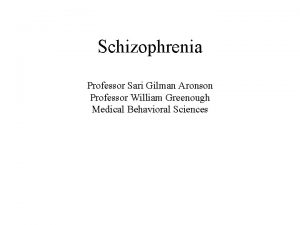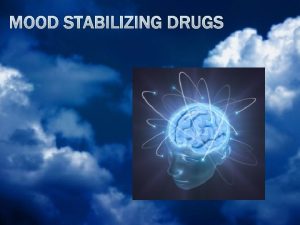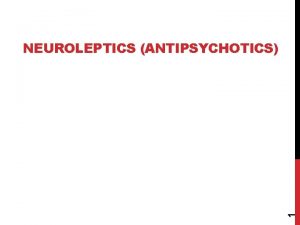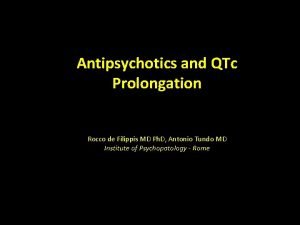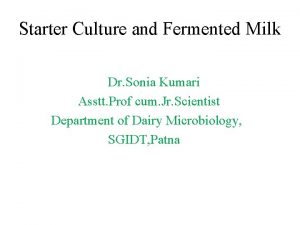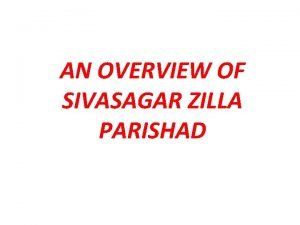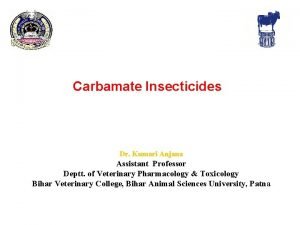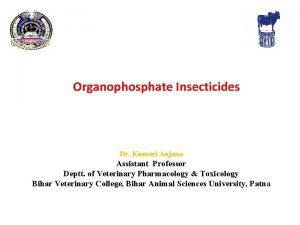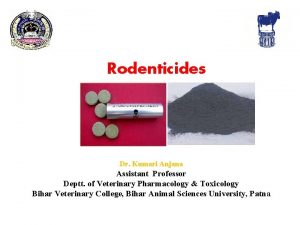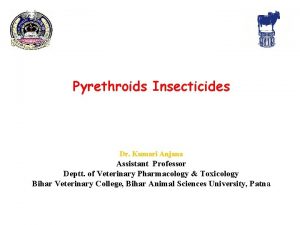ANTIPSYCHOTICS Dr Kumari Anjana Assistant Professor Deptt of











- Slides: 11

ANTIPSYCHOTICS Dr. Kumari Anjana Assistant Professor Deptt. of Veterinary Pharmacology & Toxicology Bihar Veterinary College, Bihar Animal Sciences University, Patna

ANTIPSYCHOTICS These drugs are used in psychological disorders or affective disorders. Affective disorders are nervous disorders characterized by abnormal mood. The abnormal mood changes are: 1) Depression and 2) Mania. Therefore, these drugs are of two types: 1) Antidepressants and 2) Antimaniac drugs

Antidepressants Are drugs used in the treatment of abnormal mood and behavior due to depression. These drugs are also called as Thymoleptics or Mood Elevators. Depression is characterized by feeling of sadness or misery, loss of concentration or self-confidence, disinterest in surroundings, loss of libido, anorexia, lowered energy and insomnia (sleeplessness) or hypersomnia (excessive sleep). Pharmacologically it is due to deficiency of monoamines in limbic system in brain. Depression is treated by administering antidepressants.

Classification of Antidepressants Tricyclic Anti-depressants : Impramine, Protriptyline, Amoxapine, Trazodone, Desipramine, Clomipramine, Mitrazapine, Maprotilne. Amitriptyline, Doxepine, Nifazadone, Monoamine Oxidase (MAO) Inhibitors. Phenelzine, Moclobemide, Tranylcypromine Iproniazid, Isocarboxazid, Selegiline. 5 -HT re-uptake Inhibitors. Fluoxetine, Sertraline, Fluvoxamine, Citralopram, Paroxetine, Reboxitine, Paroxetine.

Classification of Antidepressants: Tricyclic Anti-depressants: NA+5 HT reuptake inhibitors- Impramine, Protriptyline, Amitriptyline, Doxepine, Clomipramine, Mitrazapine, Nifazadone, Trazodone, Maprotilne. Predominantly NA reuptake inhibitors- Desipramine, Nortriptyline, Amoxapine, Reboxetine. Monoamine Oxidase (MAOA) Inhibitors-- Phenelzine, Tranylcypromine Isocarboxazid, Moclobemide, Iproniazid, clorgyline (MAOB) Inhibitors - 5 -HT re-uptake Inhibitors- Selegiline. Fluoxetine, Fluvoxamine, Paroxetine, Sertraline, Citralopram, Reboxitine, Paroxetine.

Mode of Action Tricyclic Anti-depressants- Act by inhibiting uptake of noradrenaline and/or 5 -HT by monoaminergic nerve terminals, thus acutely facilitating transmission. Monoamine Oxidase (MAO) Inhibitors-- Inhibit one or both forms of brain MAO: Increase stores of noradrenaline, dopamine and 5 -HT in nerve terminals. Inhibition of both MAO types correlates with antidepressant activity. 5 -HT re uptake Inhibitors-- Act by inhibiting uptake of 5–HT by tryptaminergic nerve terminals, thus acutely facilitating 5 -HT transmission.

MAOA enzyme is specific to epinephrine and norepinephrine and MAOB is specific to dopamine and 5 HT. Cheese, wine and chocolate contain tyramine, which degraded in liver by MAOA before systemic absorption. Ingestion of these foods in patients under MAO inhibitor antidepressant therapy results in server hypertensive crisis (Tyramine is adsorbed and taken up by the adrenergic nerves, converted to octopamine, a false transmitter, which releases norepinephrine from adrenergic nerve terminals).

Antimaniac Drugs Mania is characterized by excessive exuberance, enthusiasm, over self-confidence, easy irritability, aggressive behavior or hyperactivity and improper judgement. Pharmacologically it is due to dopaminergic over activity in the limbic system in brain. Drugs for treatment of mania are: 1) Lithium carbonate, 2) Carbamazepine and 3) Valproate. These drugs are also called as mood stabilizing drugs.

Lithium carbonate Lithium is a small monovalent cation (Li+). Lithium readily enters excitable cells through the Na + channels displacing intracellular K+ and is nearly equally distributed inside and outside the cells (Na+ and K+). The influx of K+ is reduced by inhibition of Na+/K+ ATPase and the electrical gradient of K+(increased extracellular K+ level). The reversal of K+ levels results in lowered neuronal excitability causing calming of the maniac individual.

Lithium carbonate contd… It also reduces release of norepinephrine and dopamine in brain, without affecting 5 -HT release. Lithium is also believed interfere with the transduction mechanisms of central adrenergic receptor activation through decreasing the formation of second messenger c. AMP and IP 3. Thus, lithium is acting through decreasing neuronal excitability and correcting the imbalance of turnover and/or actions of monoamines in brain.

Thank You
 Anjana appachana
Anjana appachana Anjana kundu
Anjana kundu Antipsychotics brain damage
Antipsychotics brain damage Atypical antipsychotics drugs
Atypical antipsychotics drugs First generation antipsychotics vs second
First generation antipsychotics vs second Chlorpromazine
Chlorpromazine Qtc prolongation female
Qtc prolongation female Promotion from associate professor to professor
Promotion from associate professor to professor Cuhk salary scale 2020
Cuhk salary scale 2020 Sonia kumarii
Sonia kumarii Chaplair v kumari
Chaplair v kumari Ambika kumari who built the sibsagar tank was the queen of
Ambika kumari who built the sibsagar tank was the queen of
